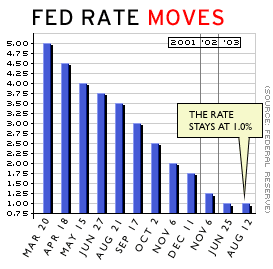NEW YORK (CNN/Money) -
The Federal Reserve, which has promised to keep short-term interest rates low for a long time, might even have found incentive in Friday's dismal jobs report to cut rates again. But would a cut do any good?

"It's not in my forecast, but it's probable, a quarter from now, if we're sitting in the same place we have been, with some uneven signs of recovery, but no real improvement in payrolls and inflation edging lower -- those are the conditions under which the Fed has cut recently," said former Fed economist Lara Rhame, now a currency analyst with Brown Brothers Harriman.
Fed officials launched a full-court press Thursday to convince the bond market they had no intention of hiking the central bank's target for the fed funds rate -- an overnight lending rate that affects other borrowing rates in the economy -- any time soon.
Bond prices have plunged since mid-June, pushing interest rates to their highest level in more than a year, in part due to fears that the Fed will soon raise short-term rates in the face of a third-quarter surge in economic growth. Bond prices and yields move in the opposite direction.
Fed governor Ben Bernanke and San Francisco Fed President Robert Parry, both voting members of the Fed's rate-setting committee, said the Fed saw few signs that inflation -- a usual hallmark of a strong economy -- or jobs growth were set to skyrocket, allowing the Fed to keep rates lower longer.
And Friday's report from the Labor Department that employers slashed 93,000 jobs from non-farm payrolls in August -- the middle of a quarter in which some economists believe gross domestic product (GDP) is growing at a rollicking 5 percent annual rate -- only helped make their case.
Bernanke, in fact, had warned the Fed could cut again. Too many more weak payrolls numbers could encourage the Fed to do just that.
Rate cutting since 2001
The central bank reduces rates to stimulate the economy by keeping borrowing costs low and raises them to fight inflation.
| 
| |

| 
| 
|

|
 Labor Secretary Elaine Chao talks to CNNfn's Rhonda Schaffler about the latest unemployment numbers. Labor Secretary Elaine Chao talks to CNNfn's Rhonda Schaffler about the latest unemployment numbers.
|
 Play video
Play video
(Real or Windows Media)
|
| 
|

|
|
The Fed has cut rates 13 times since early January 2001 to cope with the effects of a recession that lasted for much of 2001, the Sept. 11 terror attacks, a long bear market in stocks and other woes.
During the course of the long recession/recovery period, inflation has stayed mild while the labor market has remained weak, mired in its longest slump since World War II.
After fighting inflation for decades, the Fed has lately said it was worried that inflation was too low, hurting corporate pricing power and profits, and threatening eventual deflation, a potentially more damaging condition of falling prices.
Bernanke and other economists say the economy still has too much "slack" -- unemployed workers and unused production capacity. But businesses might be slow to use up that slack, thanks in part to robust productivity gains that have helped them milk more production out of fewer workers, without making expensive upgrades to facilities.
But such a view raises the question of just how effective another rate cut would be in creating jobs. After all, the Fed has slashed the fed funds rate from 6.5 percent to 1 percent, the lowest level in more than 40 years, and payrolls are still 2.8 million jobs lower than they were in March 2001.
"It's unclear what lower rates would do," said former Fed economist Wayne Ayers, now chief economist at Fleet Boston Financial. "If it's really true that productivity and structural changes are causing labor market weakness, it's not clear that another cut in rates would be helpful to the labor market."

|

